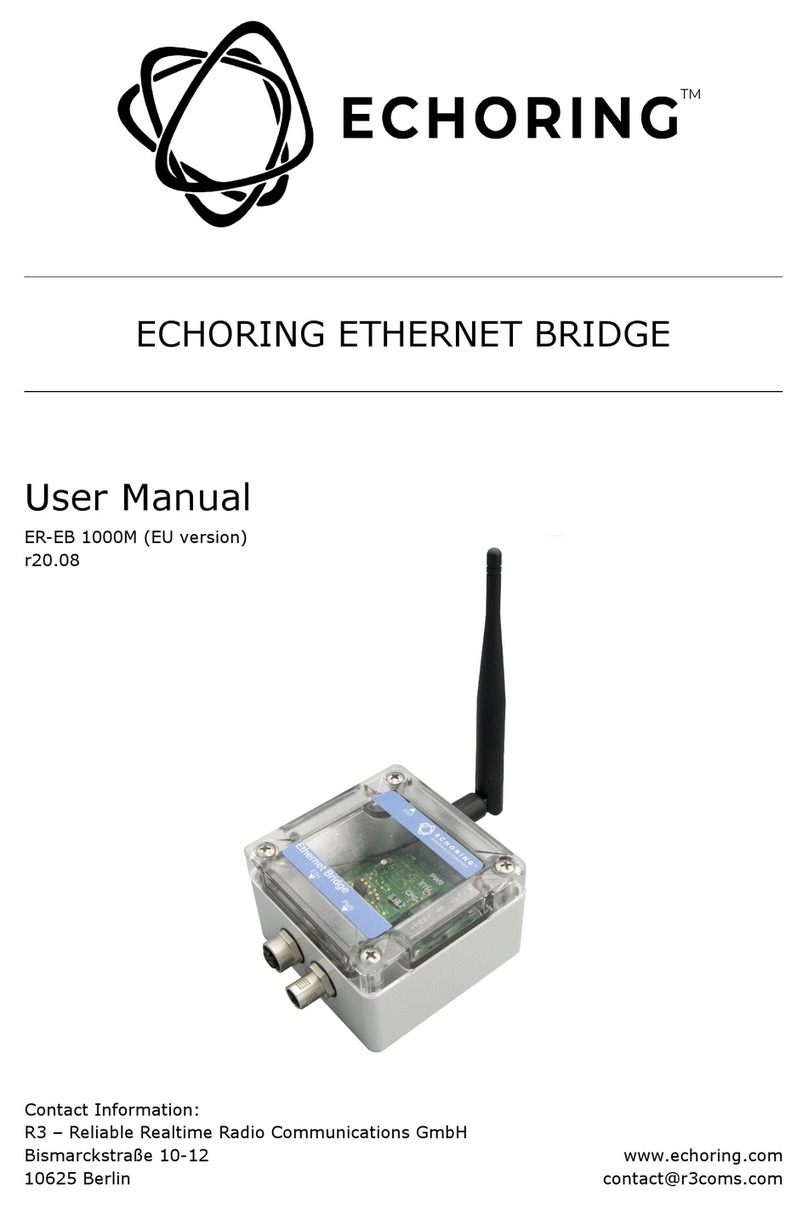
http://echoring.com
Revision: 1
3 Product Information
3.1 Intended Use of the Product
The EchoRing Ethernet Bridge (device) enables a time-critical and reliable wireless link
between Ethernet-based industrial protocol devices. It can be employed for:
• Replacing cable-based network infrastructure with a wireless connection in machinery,
vehicles and devices, enabling simplified infrastructure and flexible operations.
• Replacing network cables between moving structures or components in machinery,
vehicles and devices in order to reduce weight, size and use of installation space, as
well as wear and tear on network infrastructure.
ATTENTION — This radio device is intended for transmitting data wirelessly. It is furthermore intended
to be used for low latency and/or high reliability data communications. When using device, be mindful of
the general behavior and physics of the wireless channel. Abrupt or predictable changes in the operational
environment, such as movement of people or objects, and the presence of interfering devices, can result in
reduced wireless signal quality and failed data transmissions. Thus, when used in critical applications,
where the result of poor wireless connectivity can cause severe human injury or economic
damage, intended operations cannot rely solely on this device. A comprehensive system solution,
such as an integrated wired failsafe in case of poor wireless connectivity, must be installed and tested to
the level of intended application’s importance.
!
3.2 Localization Information and Constraints
The EchoRing Ethernet Bridge ER-EB 1000M (Version for USA and Canada) was specifically
designed to meet regulatory requirements of the FCC and ISED respectively. The Device
operates in the 5GHz Band, more specifically Channels 36, 40, 44, 48, 149, 153, 157,
161 and 165. The maximum output power at the SMA port is limited to 16.2dBm. For
any installation use dipole antennas only. The maximum antenna gain shall under no
circumstances supersede 13dBi. Do not operate the EchoRing Ethernet Bridge ER-EB 1000M
(Version for USA and Canada) in regions other than indicated.
3.3 Versions of this Product
• ER-EB 1000M (EU version) – NOT COVERED BY THIS DOCUMENTATION
• ER-EB 1000M (Version for USA and Canada) – this document
3.4 Conformity/Country Approvals
Additional information (e.g. declaration of conformity, documents, test reports, restrictions,
etc.) can be found on www.echoring.com.
3.4.1 FCC 47 CFR 15 Compliance
This device complies with Part 15 of the FCC Rules Operation is subject to the following two
conditions: (1) this device may not cause harmful interference, and (2) this device must
accept any interference, including interference that may cause undesired operation.
ATTENTION — Changes or modifications made to this equipment not expressly approved by R3 may void
the FCC authorization to operate this equipment. !
This equipment has been tested and found to comply with the limits for a Class B digital
device, pursuant to Part 15 of the FCC Rules. These limits are designed to provide reason-
able protection against harmful interference in a residential installation. This equipment
© by R3 – Reliable Real-time Radio Page 3 of 11 3. Product Information




























